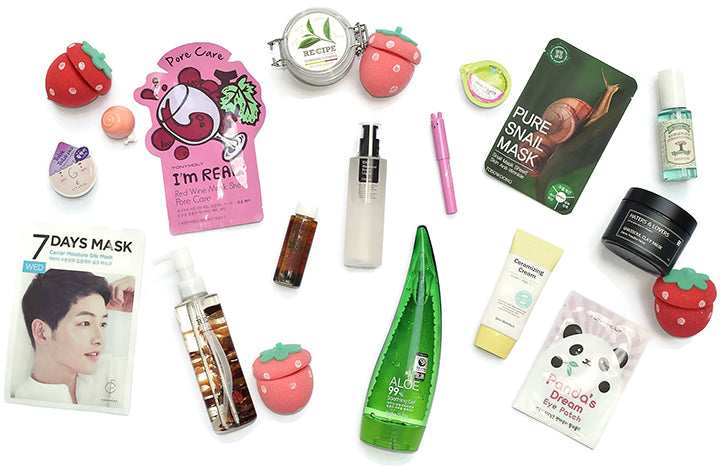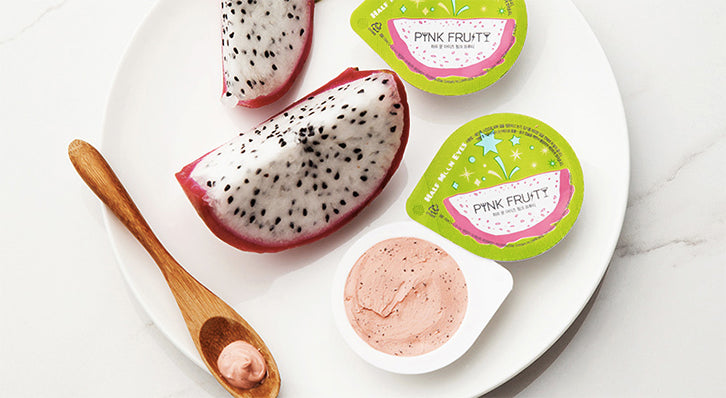How to Launch a Subscription Box: Lessons from a Successful Korean Beauty Business

I forgot to buy toothpaste again. While I’m using baking soda in an all-too-frequent pinch, essentials like razors and protein powder and, yes, toothpaste appear as if by magic, on other people’s doorsteps everywhere.
They’re not running out—these savvy consumers are shelling out their yearly budget in one transaction, paying for the convenience of an uninterrupted supply of commodities. Welcome to the $5 billion dollar subscription box industry.
Leading the pack of consumables delivered by mail is, unsurprisingly, beauty. I spend no less than $30 every time I so much as walk by a cosmetics counter. I bleed money in the presence of new mascaras that claim to give my straight lashes rollercoaster curves, or creams promising fountain of youth results. I know it’s all marketing, but there is joy in the discovery, in the pursuit of making my morning routine more effective. Or at least more fun.
In 2010, arguably the birth year of subscription boxes, the founders of Birchbox cashed in on this affliction (I was apparently not alone in my weakness) and hit the market with a simple idea: makeup and skincare sample boxes at $10 a pop, delivered monthly to beauty junkies across America.
In 2012, Birchbox went global, acquiring French company JolieBox and in 2014, the brand reported $125 million in annual sales.
Naturally, copycats and derivatives followed closely—the beauty industry becoming saturated—and it seemed that almost everything from socks to build-your-own electronics kits could be ordered by subscription. Subscription directory Hello Subscription currently lists over 4000 boxes, though the total number is much larger—there were an estimated 10,000 on the market as of mid-2015.
Sylvia Song, co-founder of MISHIBOX, imports and curates Korean beauty favorites, delivering them globally from her home in Virginia. She didn’t set out to run a subscription business, nor to become an entrepreneur. She was a science major, an accountant, a stay at home mom. Like Birchbox’s founders, she saw a gap and she filled it.
Shopify Academy Course: How to Get Started on Shopify
Looking for a guided tour of Shopify? Merchant Success Manager and entrepreneur, Samantha Renée, shares steps to customizing your shop, adding a product and making your first sale.
Enroll for freeKorean beauty
Last year, Korea exported $2.64 billion dollars in cosmetics and beauty products. K-beauty, as it’s nicknamed, has been steadily growing in popularity in North America since BB Cream—an all in one face moisturizer and makeup—hit the market here in 2011. American brands began selling their versions of the product, popularized in Korea, inspiring a devout following of K-beauty believers.

The appeal of Korean beauty extends beyond the unusual ingredients like snail slime and bee venom and artichoke extract, and even beyond the innovative packaging and product design. K-beauty is an experience, says Sylvia:
Learn More: Get ideas for things to make and sell online.
“With Korean beauty, they push this multi-step routine. There are so many different types of products and you start thinking ‘I need all of them’. I don't think it's necessary to have all the different steps all the time, but it is fun.”
Ten-step skincare regimes, hydrating animal-print masks, and peel-off lip tints are selling the ritual as much as the results. A Korean beauty box will run you about $20 USD—a fraction of the cost of a day at the spa. The lower price points are also attractive to buyers, considering the average American woman spends $15000 on cosmetics in her lifetime.
“They're effective, but also very affordable. There are a lot of dupes out there of popular American products—really good dupes and half the price of what you’d pay at Sephora.”
Korean beauty didn’t really hit Sylvia’s radar until 2014, but serendipitously, it happened around the same time that she discovered subscription beauty boxes.
"My friend gave me a bunch of Korean beauty products for my birthday. She knew I didn't like my skin and I always commented on how perfect hers looked. I started using them and really got into it. Then, coincidentally, my husband gave me a beauty box subscription. I started thinking ‘I don't really want all these beauty products. I just want Korean beauty products delivered to me every month.’ I looked for one that I could buy, but at that time, in early 2015, there were none. My husband said, ‘Why don't you just make one?’"
Meet MISHIBOX
Sylvia never imagined she’d follow in her father’s footsteps. “I didn’t really want to be an entrepreneur,” she tells me.
“My dad always told me, ‘You need to start your own business. That's the best thing to do.’ I was always telling him, ‘No, no. That's not for me.’ I didn't want to prove him right so I resisted and I resisted. I talked to my sister-in-law who's one of the co-founders now, and she was really excited about it. I thought, ‘OK, I'll give it a try.’ Before we launched, we sold hundreds of pre-orders right from the start. At that point I realized, I really couldn’t not do this.”
Before we launched, we sold hundreds of pre-orders right from the start. At that point I realized, I really couldn’t not do this.
Sylvia started her education in biology but eventually switched to biomedical engineering—a compromise that satisfied her parents as well as her own interest in tech. After graduation, she planned to move to New York to pursue nutrition, until her husband’s change of med school plans took them to Virginia.
Once planted, she discovered that there were no jobs in her field. She returned to school to study accounting, eventually working as an auditor for a CPA firm. “I decided to just look for a career that was practical,” she said.
Still, it seemed, she hadn’t found her calling. Her new career was causing her stress, too, impacting the couple’s plans to grow their family.
“I couldn't get pregnant while I was working and I think it's because I traveled so much and I was always stressed out. I'm a really bad driver and as an auditor, I had to drive to different states and I basically lived in hotels and I'd only come home on the weekends. That was really stressful.”
When her husband uprooted them again for his residency, Sylvia quit her job, and finally became pregnant. The birth of her daughter in late 2013—two months early—prompted a life decision: she would leave the workforce for good and be a stay at home mom. The gig was rewarding, but something was still missing.
"Being a stay at home mom, I love it, but I get antsy—I wanted to do something. I started blogging and then, when I discovered Korean beauty products, I blogged about it and saw a huge spike in my traffic. That's when I realized that Korean beauty was starting to become a trend. At the time you still weren’t seeing the products in Sephora. Six months later, we launched the box. We got really lucky with our timing because we launched ours when there were no others.”
When I discovered Korean beauty products, I blogged about it and saw a huge spike in my traffic.

Along with her sister-in-law Juju, her husband Kyle, and their friend Andrew, MISHIBOX (named for the company’s bunny mascot) soft launched to pre-orders in early 2015. The response was overwhelming. Sylvia’s analytic nature meant that the launch was preceded by months of research to validate her business idea, but in an instant, the pre-orders negated all of the up-front planning.
The team launched MISHIBOX on another platform, but eventually moved to Shopify for ease of setup. The business launched from the townhouse where Sylvia lived with her husband and daughter. As it grew, so did the need for space. Boxes and inventory overflowed from one dedicated room to the entire first floor of the house. Recently, the couple moved to a larger house, and the business has its own dedicated space in the ample basement.
Everyone involved in the business is doing it as a side-hustle, even Sylvia who still lists “Mom” as her full-time job. As MISHIBOX grows, though, she realizes that something will have to give, and one of the founders will need to take the plunge.

Sylvia admits that the business grew despite the lack of attention to marketing. The team decided to spend their freshman year working to “get it right”. Though they have competition now, they were the first to market with the idea, and tapped into a trend that’s affording them steady organic growth.
"Marketing is probably one of our weakest areas. We didn't really prioritize it, especially since it seemed to just be growing on its own. We've just been focusing on execution because when we started, none of us had any experience or connections in cosmetics or ecommerce. We wanted to figure out the important stuff before we got too big. Also, we were limited by our previous location at the townhouse. If we grew any faster, we would have had to move earlier.”
We've just been focusing on execution because when we started, none of us had any experience or connections in cosmetics or ecommerce.
Now, Sylvia says, they’re getting serious about growth. MISHIBOX recently expanded to one-off products, accounting for 15% of the business' sales. It’s a win-win: customers can buy more of the products they love or try out MISHIBOX’s offerings before committing, and the business can offload leftover product (ordered as buffer for defects or lost packages).
They plan to expand into other areas of Asian beauty this year, and have sights set on graduating from the basement to a dedicated warehouse space with full-time staff. [UPDATE: MISHIBOX has just confirmed plans to move to a commercial space in NYC next Spring, with Juju taking over operations.]
Well, I’m inspired.
Let’s take a look at the ups and downs of selling subscription boxes and the mechanics of running a subscription business on Shopify.
Subscription box businesses: the pros
- Predict revenue: a contract model allows you to see the future, and therefore plan/predict other aspects of the business (hiring, shipping costs, etc.) with more confidence
- Easy math: calculating customer lifetime value is a snap with a recurring billing model, a fixed product cost, and a defined contract length
- Shipping is streamlined: timed monthly boxes mean that all orders ship on the same date, in the same box, keeping shipping costs and logistics simple and consistent
- It's great for cash flow: some subscription businesses offer customers the option to pay for the full term up front (usually with a discount)
- Low cost to retain customers: subscription customers are inherently “retained” for a fixed period
- Reduce waste: you’ll buy only as much product as you need to fill boxes, eliminating the need to clear out inventory at low margins. MISHIBOX even added one-off products to the site to take care of the surplus:
"We started by just offering subscriptions but, we had a lot of inventory left over. Let's say if we have 100 subscribers, then we'll buy quantities of 120. The extra is for defective products or lost packages. The defect rate is lower than we thought it would be, and boxes don't really go missing that often, so we ended up having a lot of stock. We thought we should just sell it instead of just holding onto it.”

And, the cons
Beware that subscription businesses can also have their drawbacks:
- Factor in churn: forecasting revenue can be misleading, especially if your policies allow customers to cancel subscriptions at any time.
- Retention: onus is on the business to continuously keep the offerings fresh and the customer interested. Ask yourself: Can you source hot/new/exciting/unique products each month? What are the limitations of the industry? Do you have exclusivity with any brands?
- While the cost to retain customers is much lower, the cost to acquire can be higher—consumer commitment-phobia is high with new brands that have yet to establish trust or social proof.
- Merchants selling individual products can experiment with upselling and cross-selling to increase order value. It’s more difficult to increase a customer’s value in a fixed-price subscription model. You may need to get creative, says Sylvia:
“Recently, we started a new thing called add-ons, like the Amazon add-ons where you can pick something and it ships for free with your order. We allow our subscribers to pick what they want and then, it'll ship free with their box. That's been taking off pretty well, especially with our international customers because they save a lot on shipping.”
What’s inside the box?
Due to the recurring nature of subscription boxes, the best products for this model generally fall into one of two categories: consumables or collectibles.
Consumables:
- Tea and coffee
- Organic and wellness products
- Food: gourmet, region-specific, niche (vegan, gluten free), farmer’s market
- Supplements and vitamins
- Beauty and personal care: makeup, skincare, hair care, men’s grooming
- Baby supplies: diapers, wipes
- Pet products: litter, poop bags, treats
- DIY supplies and craft kits
- Socks and underwear
Collectibles:
Clothing, jewelry, and adult toys are other categories with significant potential for subscriptions. Remember: when choosing a product to sell in any business, subscription or otherwise, it’s important to evaluate its viability.
Getting started
MISHIBOX uses Recurring Billing by ReCharge, one of several Shopify compatible apps for subscription management. The app integrates with fulfillment apps, and others like Google Analytics and Referral Candy. The newly updated reports feature, ReCharge’s Director of Product Marketing, Chathri Ali explains, helps merchants track customer trends and revenue growth.
Founder, Mike Flynn offers some great tips for setting up a subscription on your Shopify store, including establishing shipping frequency by offering and testing multiple intervals when you first launch your business.

via: ReCharge Subscription Academy
As we’ve previously mentioned, customers can get cold feet in the face of a commitment. There is considerably more risk in signing up for a year versus buying a product once. When building your subscription business from scratch, ease customers’ decision making and grow trust for your brand:
- Earn trust: rack up some social proof by building a community around your brand: incentivize social sharing, loyalty, and reviews by rewarding your earliest customers.
- Work with influencers: you can’t afford Beyoncé, but new emerging YouTubers, Instagrammers, and bloggers will sometimes be willing to review your box for product alone, or a lower rate. Build relationships with influencers early on—as their audiences grow, yours could too.
- Reduce risk: offer a substantial discount to customers who pay upfront for a subscriptions, or offer the first month free.
- Partner with other subscription businesses: the customer who opts to have cosmetics delivered monthly may be the same profile of a potential customer for your wellness box—customers already comfortable with the subscription model are low-hanging fruit. Team up with complementary businesses by trading postcard inserts in boxes or mentions in email newsletters.
- Provide options: like MISHIBOX, offer one-off products or single-month boxes as a preview for customers. Upsell them on the box or the subscription.
- Offer gift subscriptions: expand your audience to the friends and family of your ideal customer. Allow customers to purchase gifts with shorter commitments and personalized messaging.

Accidental entrepreneur Sylvia Song, finally found her calling in subscription box beauty. The business has been thriving under the direction of a team with no experience in ecommerce or beauty. The secret of their success is good timing—recognizing a trend early on—and a healthy balance of gut instinct and careful planning.
“Don’t quit your day job,” says Sylvia when I ask her advice for other budding entrepreneurs. While she’s conservative, she can see the other perspective.
“My sister-in-law's different. Her advice would probably be not to overanalyze it. You're never going to know if your business is going to be good or not until you actually launch it. We wasted all that time and money trying to hire developers and build that first website. I spent probably two months just analyzing whether this business would work when we could've just launched pre-orders. The orders would've flooded in that would've validated my idea right away.”
You're never going to know if your business is going to be good or not until you actually launch it.
Ready? Get started:
